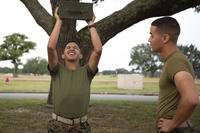How many miles per week should you run before attending Navy SEAL training? This is the most common question asked by candidates preparing for the high attrition rate school known as Basic Underwater Demolition/SEAL training (BUD/S). It depends on your athletic history, injury history and running ability, but the answers are all over the place and range from 20-25 miles a week to 50+ miles per week. Here is the same question asked with a few added specifics to help determine an answer that fits his timeline and abilities:
Hey Stew! I'm leaving for boot camp in about 3 months, then to BUD/s. Should I keep the running miles at 25 or increase mileage? Thanks DJ.
DJ, I am in the camp that as long as you are within a range of miles between 25 and 40 miles per week, you are solid, but you also have to be able to run several miles at a seven-minute mile pace. This level of pacing is needed because every week, you will have a four-mile timed run wearing boots and pants on the hard-packed sandy beaches of Coronado, California.
Easily doing a 28-minute, four-mile timed run in these conditions requires considerable conditioning to learn that pace. This goal pace will set you up to be in the top 25% of the class when you start and four minutes under the minimum standard of 32. While it is true that all you have to do is pass a 32-minute, four-mile run in the first phase, there are better ways to begin your special operations journey than flirting with the minimum standards.
All it takes is a bad day, and you have a failure on your record. You are allowed to make it up, but if you do not meet the standard in any event at BUD/S, you will be kicked out or rolled back to the beginning of training (if you are lucky).
Given you have three months, progress logically with a 15% increase in total miles per week. The miles and weeks add up fast at this level, and soon you will be in the mid-30 miles per week range. As long as you are not feeling any pain or overuse, keep going up, but stopping at 40 miles is fine. It is OK to mix in a long, slow distance (Zone 2) run to get some of the miles, too, but you will still want to do a four-mile timed run, goal-paced runs (a seven-minute mile pace), sprints, hills and/or soft sand, if available. If you do not have hills or sand where you train, try the stair-stepper machine (or find stairs) to run up and down to work the legs on leg day. See the related stair-stepper article and run/leg PT workout.
Everyone's needs are different, but the standards are the same at BUD/S. Some running athletes do not need to double down on their running strength but must work on their overall strength and durability, as load-bearing activities will challenge them more than any timed running event. For those athletes in the strength and power field, running and doing calisthenics more and lifting less is the journey that will help you with the needed endurance, muscle stamina and overall work capacity to make it through training.
Running well and being durable enough to handle the miles per week and load-bearing events is essential to your success. While there is no single answer to this question, many will fail to meet the standard in timed run events (underprepared for the pace), and many will get injured because of overuse injuries (underprepared for the impact).
However, many people will also quit because it is cold, from discomfort in the water (treading, drownproofing, scuba diving at night) and/or the daily grind of long days and nights. With the time you have left before joining, consider working and focusing on the weaknesses that will be exposed in those first few weeks. If your running is solid, do not add 20 more miles per week just to get 50+; instead, spend that time in the water or the weight room if you have other weaknesses.
I have seen many graduate BUD/S having only run 25 miles a week (or less), but they were fast-paced and still durable enough to handle the running, rucking and load-bearing. I have also seen athletes go to BUD/S with 50-60 miles per week in their training and make it. However, there were opposite outcomes for both of these stories as well. I suggest finding the range that is comfortable to you without pain while also hitting performance goals of that seven-minute mile or sub-seven-minute mile pace for four-mile events.
Stew Smith is a former Navy SEAL and fitness author certified as a Strength and Conditioning Specialist (CSCS) with the National Strength and Conditioning Association. Visit his Fitness eBook store if you're looking to start a workout program to create a healthy lifestyle. Send your fitness questions to stew@stewsmith.com.
Want to Learn More About Military Life?
Whether you're thinking of joining the military, looking for fitness and basic training tips, or keeping up with military life and benefits, Military.com has you covered. Subscribe to Military.com to have military news, updates and resources delivered directly to your inbox.





















